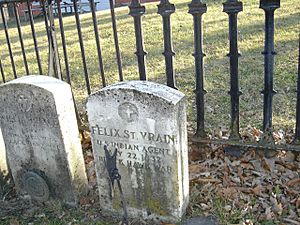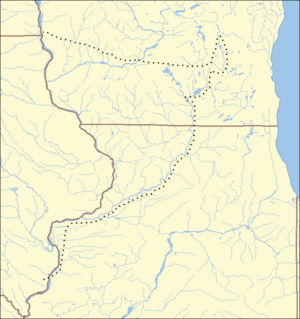St. Vrain massacre facts for kids
Quick facts for kids St. Vrain massacre |
|||||||
|---|---|---|---|---|---|---|---|
| Part of the Black Hawk War | |||||||
 The graves of Felix St. Vrain, at right; alongside victim, William Hale, at left, and his companions, John Fowler and Aaron Hawley, are buried in Kellogg's Grove Cemetery, Kellogg's Grove, Stephenson County, Illinois |
|||||||
|
|||||||
| Belligerents | |||||||
| Ho-Chunk or Sauk/Fox | |||||||
| Commanders and leaders | |||||||
| Henry Atkinson Felix St. Vrain (Indian agent) |
|||||||
| Strength | |||||||
| 7 | approximately 30 | ||||||
| Casualties and losses | |||||||
| 4 | 0 | ||||||
The St. Vrain massacre was a sad event during the Black Hawk War. It happened on May 24, 1832, near a place called Kellogg's Grove in what is now Pearl City, Illinois. This event involved a group of Native American warriors and a small group of travelers.
The attack was likely carried out by Ho-Chunk warriors. These warriors were not part of Black Hawk's main group. It also seems their nation did not approve of their actions. Four people died in the attack. One of them was Felix St. Vrain, who worked for the United States government as an Indian Agent. An Indian Agent was a person who worked with Native American tribes on behalf of the government.
St. Vrain and his group were on their way from Dixon to Galena, Illinois. General Henry Atkinson had asked St. Vrain to deliver important messages to Fort Armstrong. After the attack, Colonel Henry Dodge and his soldiers buried the bodies of St. Vrain and his friends.
Before the Attack
Felix St. Vrain was a U.S. Indian Agent for the Sauk and Fox tribes. He was traveling with several companions. These included John Fowler, William Hale, and Aaron Hawley. These men, along with St. Vrain, were all reported to have died in the attack. Thomas Kenney, Aquilla Floyd, and Alexander Higginbotham were also with St. Vrain.
The Native Americans who attacked the group were not part of Black Hawk's main group of warriors. However, they were on their way to join Black Hawk's group when the attack happened. Older stories said the attackers were Sauk warriors. But newer information suggests they were linked to the Ho-Chunk nation. Black Hawk himself said in his autobiography that the group was Ho-Chunk and not part of his warriors.
Most Ho-Chunk people actually supported the United States during the Black Hawk War. The warriors who attacked St. Vrain's group acted on their own. They did not have permission from the Ho-Chunk nation. As the war continued, many white settlers began to fear all Native Americans. They did not always see the difference between friendly tribes and those fighting. This led to fear of all Native Americans in the area. This was true even for those who were friendly to the settlers.
For example, a newspaper in Galena wrote about the attack on May 30, 1832. The article described the killings. But it also wrongly connected the murders to the Sauk and Fox people of Keokuk's group. Keokuk and his group were not near the attack site. They had even offered to help white settlers against Black Hawk's warriors.
The Attack at Kellogg's Grove
| Map of Black Hawk War sites Symbols are wikilinked to article |
The St. Vrain massacre took place near what is now Pearl City, Illinois. This area was known as Kellogg's Grove. Before the attack, Felix St. Vrain was in Dixon. He was under the command of General Henry Atkinson.
A group of men, including Aaron Hawley, John Fowler, Thomas Kenney, and Alexander Higginbotham, had been buying cattle. They heard about trouble with Black Hawk's group. They decided to return home quickly to northern Illinois to protect their families. On May 22, 1832, they left Dixon for Galena, Illinois. At Buffalo Grove, they found the body of William Durley. He had been killed in the Buffalo Grove massacre. The men immediately went back to Dixon to report what they found. They stayed in Dixon overnight.
The next day, General Atkinson returned to Dixon. He had messages that needed to go to Fort Armstrong. Atkinson told St. Vrain to travel with the Hawley party. He asked St. Vrain to deliver the messages to the fort. The men traveled north from Dixon back to Buffalo Grove. There, they buried Durley's body. They then traveled another ten miles toward Fort Hamilton before camping for the night.
The next morning, May 24, they started traveling again. After about three miles, they stopped to eat breakfast. As they finished eating, about 30 warriors appeared. The men tried to get away. But four of them were shot and killed. Those killed with St. Vrain were John Fowler, William Hale, and Aaron Hawley. General George Wallace Jones was St. Vrain's brother-in-law. He was the one who identified St. Vrain's body.
Three men managed to escape. These were Thomas Kenney, Aquilla Floyd, and Alexander Higginbotham. They avoided the warriors and arrived safely in Galena, Illinois three days later. It is believed that Aaron Hawley first got away from the scene. But he was later killed as he fled.
After the Attack
The three men who escaped, Floyd, Higginbotham, and Kenney, arrived in Galena on May 26, 1832. They told their story to a local newspaper. However, there was some confusion about Aquilla Floyd. Some believed he was killed in the attack. His name was even put on a monument with the other victims. This monument is in a public park in Kellogg's Grove near Kent, Illinois.
But public and military records show that Aquilla Floyd survived. He was released from the military on August 20, 1832. He went back to his home in Kentucky. He died of old age in 1879. His body is not buried at the monument. His name on the monument was a mistake made in 1886. People likely thought he died because they couldn't find records of him in Iowa.
After the attack, Colonel Henry Dodge and his soldiers buried the bodies of St. Vrain and some of the other victims. Dodge and his men found the bodies of St. Vrain, Hale, and Fowler. However, the body of Aaron Hawley was never found.
Images for kids





